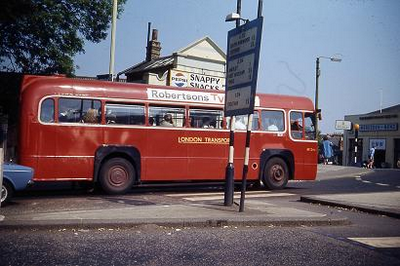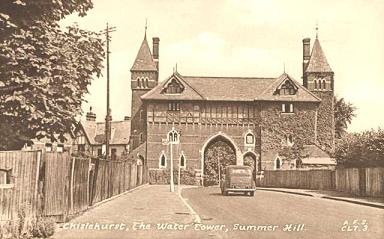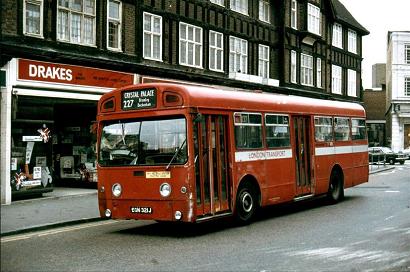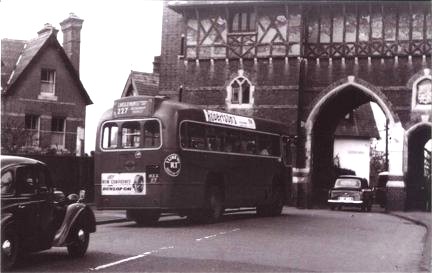|
|
 Red RF routes Red RF routes
Route 227
Page last updated 29 November
2018
Originating as a first world war munitions route,
the 109 between Penge and Chislehurst was transferred to Tilling
and was renumbered in 1934 into the single-deck series as
227. It still operates over the Crystal Palace to Bromley
section today and is the longest running single-deck service in
London. The centenary of the route was celebrated with a
heritage operation in connection with
Bromley Garage open day on 13 August 2016.
Brand new RF338 in
Penge. The bus has run down from Crystal Palace past the
church of St John the Evangelist and now passes the Crooked Billet
short working terminus. The pub sign illustrates the now-lost
meaning of 'billet' as a stick or vine.
Photo © Geoff Morant, Mike
Morant collection
Dates of RF operation
5 Nov 52 to 1 Jan 71
(total 18 years, 2 months, all crew operation).
Destinations
CRYSTAL PALACE and CHISLEHURST
 Reason for single-deck operation Reason for single-deck operation
Single-deckers were required both due to the low bridges at
Clock House and Shortlands and the famous Chislehurst Water Tower
at the top of Summer Hill, through which all traffic from Bromley
to Chislehurst had to pass until it was demolished in 1963.
Although Clock House no longer provides a barrier, the bridge at
Shortlands still only has a 12' headroom, leading to the route
being the longest running single-deck operation in
London.
RF344 in May 1968, newly repainted and still
bearing side adverts, having left the stand at Crystal Palace
Parade and about to run round the roundabout. Snappy Snacks
no doubt provided tea to crews on the 154
and 157, which terminated at the top of
Anerley Hill.
Photo © John King
Route history
Thomas Tilling introduced a horse bus service from Forest Hill
via Penge and Beckenham to Shortlands in April 1913, the first
public service along this route (Beckenham had been in negotiation
for a tram service to Bromley in 1901-3, but this foundered partly
due to the low bridge at Shortlands). The Tillings horse bus
did not run the last half-mile into Bromley due to the steepness of
the hill up Beckenham Lane. It was shortened at the western
end after six months, to run only from Penge.
The first motor bus route between Penge and Bromley was the
112, which ran using single-deck 'rear-verandah' B-types from June
to August 1914 and from December 1914 to January 1915. The
road was covered again by new route 109 in August 1916, which was
introduced as a 'munitions service' from Penge Crystal Palace
Entrance, via Beckenham, Bromley, Chislehurst and Eltham to
Woolwich Eton Road. Operation was by the General
from Streatham garage (AK). The route ceased operation when
funding stopped after the first war ended, in February 1919, but
was reintroduced in September that year to work between Penge and
Bromley North, extended further to Chislehurst six months later
on the familiar orbital route round London's outskirts
linking Penge, Beckenham, Bromley and Chislehurst Queens
Head.
An indication of the conditions faced by drivers is given by
the official 'traffic circular' dated 13 March 1920, which includes
the following: 'Drivers are instructed to vary the part of the
roadway used in each journey, particularly between the Queens Head
and Chislehurst Station, and not to keep in the same rut each
time'.
The first B-type buses used on the route also could not
manage the steep hill on Beckenham Road up into Bromley, so worked
eastbound via Blyth Road until replaced by new buses in 1925.
The service was briefly extended westwards in 1921, to Sydenham and
then to Forest Hill, and transferred from Streatham garage to be
operated by Nunhead (AH), using some of the type-7 Bs that had
proved too heavy for the 111.
The 109 ran through the heart of Thomas Tilling
territory. In May 1924, the operation was transferred to
Tilling's Bromley garage (TB), although formal agreement
didn't follow until October 1925. The General loaned 12 Bs
until a dozen O-class 30-seat TS7 petrol-electrics arrived [see
foot of page]. These were owned by General, and until 1930
were operated in General colours (at which time they were licensed
in Tilling's name and repainted accordingly).
 Under the Bassom scheme introduced on 1 Dec 24, the
Penge terminus was registered as Crystal Palace Entrance, but the
route ran (as the 109 A) only from Penge Crooked
Billet. On 16 Jun 26, the route was extended north from
Chislehurst via Mottingham to Eltham High Street with a
bus every 10 minutes and renumbered 109 (because the Crystal Palace
Entrance terminus was withdrawn). To cover the additional
requirement, Tilling's TS7s were assisted by three General Bs from
Sidcup (SP), these being replaced by K-types during 1927,
until 1930 when the TS7s had been converted to pneumatic tyres and
Sidcup's involvement ceased. At the end of that year, a
further frequency improvement required the addition of two buses
from Elmers End (ED) plus extras from AH and ED at
weekends.
The Chislehurst Water
Tower, dating from 1860
Single-deckers were required both due to the low bridges at
Clock House and Shortlands and the famous Chislehurst Water Tower
at the top of Summer Hill, through which all traffic from Bromley
to Chislehurst had to pass until it was demolished in 1963.
While TB was still operating petrol-electrics, ED received six LT
Scooters for the route at the end of 1931 (including three
secondhand from double-decking at Hounslow), removing AH's
involvement, although the Scooters were gradually needed
elsewhere and Ss reappeared on the route at weekends until 1934,
alongside Ts; 1933 saw AH helping again at weekends, also mostly
with Ss.
Meanwhile, a batch of AEC Regals (3T3s, numbered
T307-318, with bodies built by Tilling at their Obelisk Works in
Lewisham) was bought by General in 1932 for Tilling to operate
and replaced the TS7s at TB between August and
October. The buses were notable for their exceptionally
wide destination screens, and two were unusual in being built with
pre-select gearboxes, Tilling's first. Tilling's operations
were taken over by General in October 1933. In May 1933, the
route was extended from Eltham to Welling Guy Earl of
Warwick.
RF415 was delivered new to
Sutton in January 1953, but the following month sees it loaned to
Bromley and using the blind from a Scooter (this loan is noteworthy
as Sutton and Norbiton did not themselves have enough RFs to work
the 213, which had its peak
allocation on Saturdays, like the 227). The effect of the
cream band is more striking without the indicator ears.
Photo © AB Cross
A sister route to the 109, the 609 worked by Elmers End,
had been added on 1 Apr 31, running between Penge and Bromley North
Station but routed to the south of Shortlands (thus avoiding both
the railway bridge and the water tower). Again, the ED
allocation varied between Ts and LTLs, with Ss working a joint
allocation with the 109 A (Penge to Bromley shorts) on
Saturdays in 1934 - the Ss were time expired by then, but Saturdays
as the busiest day mean they needed to be brought out from
storage. They were eventually withdrawn when the 551 (later
251) was shortened, releasing more
Scooters, although surviving a little longer elsewhere.
From November 1932 to January 1934, the 609 was extended to
Chislehurst and onwards, replacing the 195 (later 228), to Eltham. ED was joined by Sidcup
(SP), both operating Scooters. The simple meeting of the 227
and 228 at Chislehurst of the RF years had a long and complex
history.
The 609 became the 229 in October
1934, then (to avoid confusion of numbering with the 227) the
254 until, in 1940 and by then cut back
to Beckenham, it was double-decked as the 126.
The 109 was renumbered 227 in the
new sequence on 3 Oct 34. By now running every 7½ minutes
over most of the route, larger buses were required and LT Scooters
replaced the 3T3s in March/April 1936. The ex-Tilling Ts
were moved to Kingston and replaced at TB by LTs. At the same
time, SP added three more Scooters on Saturdays, from 1929 the
busiest day of the week.
On 4 May 38, the route was cut back to Chislehurst Gordon
Arms, running from the Common along Green Lane in both
directions. The sections to Welling was covered by new routes
160 and 161. On the same day, the TB and SP allocations were
withdrawn, leaving the route to ED's Scooters, in sole charge until
1951. During this period, the vehicle requirement grew from
11 to 21 during the week, 17 to 24 on Saturdays; for much of the
war, the Scooters were joined by a sole Q, Q217. This
was destroyed on 18 July 1944 when ED received a direct hit
from a V1 flying bomb, killing 16 staff and destroying more
than 40 buses. Despite the devastation, services
continued the following day with borrowed buses, including eight
stored green 1/7T7/1s relicensed for the period 20-31 July on the
227 (there were also 27 ex-Tilling STs relicensed and 7 green STs
loaned from the Country Area). In part, these were replaced
from 1 August by Scooters that had gone to Chiswick for
overhaul but were relicensed, alongside damaged buses that had been
repaired.
On 2 May 51, the route moved wholesale back to TB, its home from
then until today, except for a five year contract 1992-97 with
Kentish Bus out of Dunton Green. The Scooters moved with it,
Bromley's first single-deckers since the double-decking of the 254
(to 126) and 232 (to 138) in 1940,
the duties replacing part of the 47 that moved to Catford, in turn
replacing the 36 which moved to the brand new Peckham garage.
Still doorless, RF324
stands at Crystal Palace in front of Stockwell's RM930 on the
long 2 to North Finchley. The RF is one of those
converted to OMO configuration in 1970 and returned for a brief
period at TB with the doors fixed open. Crews were happy to
have the benefit of the doors, however, and reportedly often
carried a screwdriver to remove the wooden batons stopping the
doors from closing.
Photo © Chris
Stanley
On 27 Jun 51, the 227 was extended from Penge to Crystal
Palace, although this was a minority of buses, two or three turning
in Penge for every through bus. The LTL Scooters were
replaced by new RFs in November 1952, with the last four (including
ex-London General Country Services LT1427) being withdrawn
after service on 3 December. The first 3 RFs
were licensed on 5 November, twenty more were delivered during
the month and the last six by 12 December. It is
interesting to note that the nickname 'Scooters' lasted to be
applied to RFs at Bromley, and a few other garages, but not
universally.
Saturday was still the busiest day on the route, and Bromley
garage continued to put out more buses on Saturdays through until
1963. However, until then and from well before the
introduction of RFs, the Saturday allocation was higher than the
number of single-deckers based at the garage, so every Saturday a
bus would be borrowed from another garage. [See more
information on borrowings here.] For example, from 1958 to
1963, Bromley had 22 RFs allocated but 23 were required for the
service on Saturday afternoon. Each Saturday morning,
one RF was driven from Croydon to Bromley, ran in service during
the afternoon and (we believe) went back that evening, with
the ferry driver from Croydon staying at Bromley Garage for
the 4-5 hours that the bus was out. TC had one spare bus
(six RFs for a Monday to Saturday PVR of five), so between
Croydon and Bromley, all 28 RFs were in use. It is testament
to the reliability of the RF that this system worked.
During 1954, there were detail changes to the route at
Chislehurst. The terminal working was unchanged (the
stand was in Alexander Road, beside the Gordon Arms, with the buses
leaving via Edward Road), but from May the route arrived and left
via Albany Road and the High Street, changing again in October to
arrive via Albany Road and depart down Green Lane to the
Common. Other than this, and a gradual reduction in weekend
frequencies, the route remained unchanged for approaching 20
years. For much of the period, Crystal Palace buses
alternated with Penge Crooked Billet short
workings.
 Just before the end of the RFs, LOTS
reported that 'RF348 was taken from outside Bromley garage at 3am
one morning and the joy-rider ended up crashing into the front of a
shop. When the RF was seen being towed through Bromley it looked a
complete write-off. The joy-rider was not found.' RF348 was
indeed a write-off, it was one of two scrapped at Aldenham the
following year.
The route was the
second last crew-operated RF route (the last was the 236) when converted to OMO Swifts on 2 Jan
71, having been the only RF route operated out of Bromley for all
that time. The last bus in service was driven by the late
Fred Chapman, a proud RF owner for years afterwards. In
common with experience elsewhere, the conversion to Swift operation
was a disaster - see former conductor Terence Uden's comments
below.
SMS321 seen in Bromley
Market Square.
Photo Jeff Lloyd
collection via London Bus
Scene
The Swifts were replaced by Nationals after only
6½ years, these lasting until the route was won
by Kentish Bus, operating from Dunton Green, in 1992. At that
time, the route was cut back from Chislehurst to Bromley North,
leaving the route as operated today. However, operation
returned to TB, now as Stagecoach, in 1997, where it remains
running between Crystal Palace and Bromley North to this day.
Map © London Transport 1955
RF route in detail, with timing
points
CRYSTAL PALACE Parade, Westwood Hill, Crystal Palace
Park Road, Penge High Street, Penge
Pawleyne Arms, Penge High Street, Beckenham Road,
Beckenham War
Memorial, Beckenham High Street, Bromley Road,
Shortlands Station, Beckenham
Lane, Bromley High Street, Bromley
Market Place, Widmore Road, Bickley Road, Bickley
Park Road, Chislehurst
Station, Summer Hill, Bromley Road, Chislehurst War Memorial, Centre
Common Road, High Street, Albany Road, Green Lane, CHISLEHURST
Gordon Arms. (Return via Green Lane, Heathfield
Lane, Loop Road, Centre Common Road).
Garage journeys: to/from Bromley Market Place via
High Street, Masons Hill, Bromley Common (some drivers on
empty late journeys from Chislehurst are said to have
used a short-cut from Bickley).
Crew change at Bromley Widmore Road.
Terminal working at Chislehurst: turn into Alexander Road to
stand, leave via Edward Road to Green Lane.
Terminal working at Crystal Palace: from Parade south side via
roundabout at the top of Anerley Hill; the original working is
believed to be by U-turn across Parade, but the roundabout was in
use by 1948.
Terminal working at Penge: turning circle at Crooked
Billet.
Frequency
| Year |
Mon-Fri |
Sat |
Sun |
| 1936§ |
7½ mins |
7½ mins |
7½ mins |
| 1941 |
6-7½ mins |
5-7½ mins |
8-10 mins |
| 1946 |
5-6 mins |
4½-6 mins
|
6-7½ mins |
| 1951 |
4-6 mins |
4-6 mins |
6-7½ mins |
| 1959 |
4-7 mins* |
4-7 mins* |
6-8 mins* |
| 1964 |
4-7 mins* |
4-5 mins* |
9 mins* |
| 1969 |
3-7 mins* |
4-7 mins* |
9 mins* |
* Chislehurst to Penge. Every second or third bus ran to
Crystal Palace.
§ Frequencies for Penge to Eltham
(route continued to Welling). Additional buses ran on
Saturdays Penge to Bromley (overall up to every 5 minutes).
Chislehurst to Penge took about 38 minutes, to Crystal Palace
about 45. The November 1959 timetable is here, the July 1967
timetable here and the July 1969 timetable
here.
Faretable
To view the post-RF faretable for 1979, click here.
 RF allocation RF allocation
New RFs delivered Nov-Dec 52: 331, 333-353, 358-360, 369, 377
(26 + 1 spare), Feb 53: 463.
PVR 1952 (Nov): Mon-Fri 24, Sat 26, Sun 15
PVR 1958 (Apr): Mon-Fri 24, Sat 23, Sun
15
PVR 1958 (Nov): Mon-Fri 20, Sat 23, Sun
12
PVR 1959 (May): Mon-Fri 20, Sat 23, Sun
15
PVR 1959 (Oct): Mon-Fri 21, Sat 23, Sun
12
PVR 1960 (May): Mon-Fri 21, Sat 23, Sun
15
PVR 1960 (Oct): Mon-Fri 21, Sat 23, Sun
12
PVR 1962 (Oct): Mon-Fri 21, Sat 23, Sun
10
PVR 1963 (May): Mon-Fri 21, Sat 23, Sun
12
PVR 1963 (Oct): Mon-Fri 22, Sat 22, Sun
10
PVR 1964 (Nov): Mon-Fri 22, Sat 20, Sun
10
PVR 1969 (Aug): Mon-Fri 23, Sat 20, Sun 7
RF385 in earlier
years about to take the Chislehurst Arch. The bus spent
much of its life at Bromley. Another photo of the arch,
taken from the other side, appears in John Hambley's 1961 book
(p.21).
Photographer unknown
Memories
Terence Uden conducted on the 227 and recorded his
memories in
LHRG Bulletin 199. They are copied here with his
permission:
‘I was very happy to have worked on RFs for nine years as a
Conductor at TB, although, unlike most LT garages, we did not
(thankfully) stay on one route all the time. In fact, on the
terrible day of conversion, 2 January 1971 I recall, TB went over
to a fully common rota for crews as the OMO rota had been from
inception, and the 47 duties joined the 61, 94, 119 an 146
rota. Prior to the introduction of OMO in 1968 [this was the
126], there had been three rotas, but all of them contained varying
elements of RF work on both Saturdays and Sundays, so all crews
worked them at some point, and as they by far exceeded the number
of duties (up to 48 Mon-Sat) on any other route, it was rare not to
be working an RF at some time each month, even if only on overtime
or a rest day.
With regard to the comment about “the
disaster” of the conversion of the 202 at
NX, this was certainly reflected in greater magnitude at TB after
conversion of the 227. The revenue literally halved, and lost
mileage, hitherto almost unknown apart from conductor shortages
towards the end, spiralled to create an almost complete breakdown
of the service. LT must have been fully aware of the
consequences of conversion, as from day one, they had already
instituted a formal turning arrangement at Widmore Green (blinds,
stands, etc), and I can recall actually seeing three consecutive
buses being turned at that point. How the residents of
Bickley and Chislehurst, after enjoying a four-minute peak service,
not to mention am peak ‘shorts’ worked just from the Gordon Arms to
Chislehurst Station, coped with routine gaps of up to an hour, of
course was reflected in the appalling loss of revenue. I
recall some Chislehurst passengers actually taking the 45 minute
journey on a 61 via Orpington as the only sure means of getting to
Bromley! With the later mechanical difficulties of the SMS
class, it took years for the service to really recover, and the
numbers carried by the wonderful and hard-working RFs, which
negotiated three steep hills on each journey, never returned.
Although we had one OMO-fitted vehicle for
some time, much sought-after on cold winter nights with the added
luxury of a door which could be controlled Country Area fashion by
both conductor and driver, during the last six months, many
vehicles fitted for OMO and the future ‘Uxbridge’ scheme came our
way, where only the driver controlled the doors. This reduced
capacity by two, but did stop people flinging themselves onto the
steps at the pedestrian crossing encountered immediately after
leaving the eastbound stop in Bromley Market Square. This
happened on almost every journey during the busy daytime, and the
astonished looks of those now unable to do this was a sight to
behold. On the very last day, Friday 1st January
[1971], then a perfectly normal working day, we were actually
scheduled to do the very last handover in the Market Square at 2139
that night, the crew of the final bus into TB taking over.
But we also had a spell of overtime that morning, also on the 227,
and I was astonished to be given a £5 note by an elderly male
passenger in Bickley, who I vaguely recognised but never thought of
as particularly friendly, with the comment “thank you for all the
service you have given us on this route”.
As a post script, I recall that when we
regained the 47 route on a Saturday, sometime around 1982, a
youngish woman boarded in the Market Square as were heading back to
TB, looking at me as if she’d seen a ghost. “How are you?”
she gushed, “I can’t believe you are still here, and thought you
had left when the 227 lost its conductors”. Happy days!’
Terry Cooper, Roger Newport and Ian Smith all remember RFs on the 227,
read their accounts on the next page.
In Bus Crew: London 1924-1970 by Jim &
Mary Cooke, Jim has the following about the 227. ‘Eventually
we lost a number of 47 duties to Catford garage. These were
replaced by 227 duties that had previously been worked out of
Elmers End. The buses were old LT-type single-deckers, bad to
work on and to drive. Later on they were replaced by RFs,
which were much better to drive and even had a heater in the
cab.
One night we were proceeding up Summer Hill at
twelve o’clock, being the last 227 to Chislehurst. On going
through the water-tower, I misjudged the entrance – this was quite
narrow, with only a three-inch clearance on either side – with the
result that I hit the nearside pillar of the tower and knocked off
the mirror, which fell on Mary’s foot as she was standing beside
me. The impact also broke the handrail on the right hand side
of the entrance. Luckily I had a piece of string in my
pocket, so Mary and I tied the handrail up as best we could and
carried on to Chislehurst. When the people wanted to get off,
Mary descended first and held the handrail to make sure they did
not slip or fall into the road. Of course, I had to sign up
for this [a ‘caution’ in the disciplinary book]’.
Re-creation
RF486 operated route 227 at the Sidcup
Running Day in 2007 and (with other RFs) at the Bromley Running
Days in 2009, 2010, 2011, 2012, 2015, 2016 (twice) and 2017.
Early fleet details
Thanks to GJ Robbins in LHRG Bulletin 81, we know that the
twelve single-deck Tillings TS7s were placed in service on the
109A on 7 Oct 25, with O168-179 working the following
duties (in order): TB1, TB2, X, TB3 - TB11, X being the spare
bus. This allocation remained unchanged throughout.
|
|